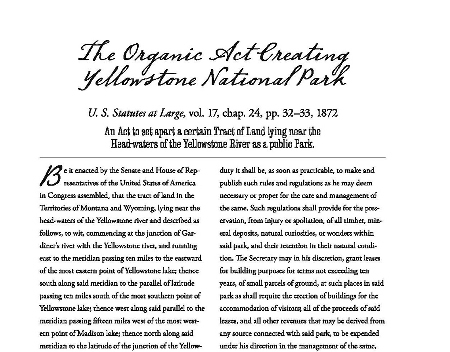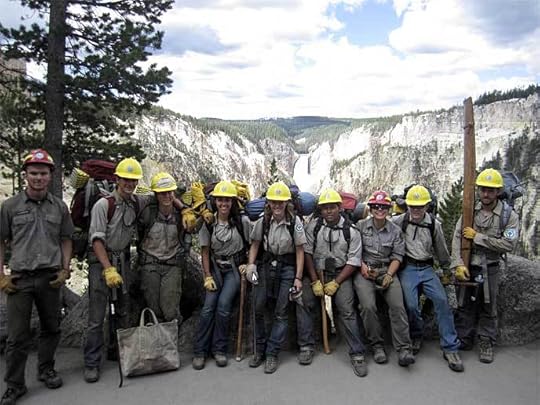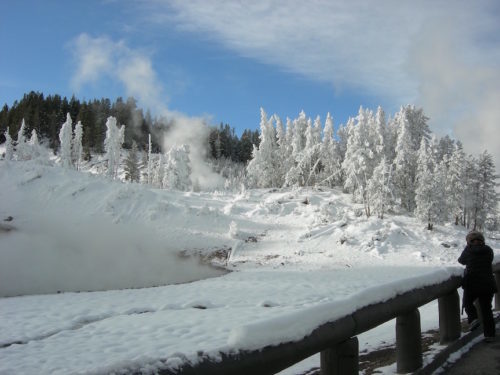Janet Chapple's Blog, page 6
March 20, 2018
Yellowstone Treasures named finalist in two book award contests
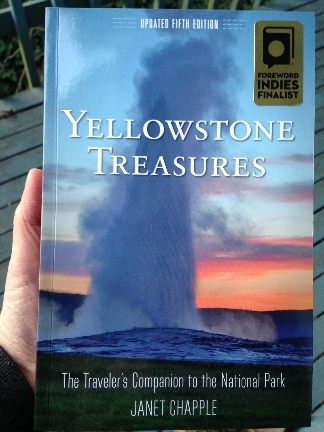 Big news! On March 14, 2018, the Independent Book Publishers Association announced that Yellowstone Treasures: The Traveler’s Companion to the National Park, updated fifth edition (2017) is a finalist in the 30th annual IBPA Benjamin Franklin Awards in the travel category. This is a true honor, since finalist status with IBPA means the book will receive either a Gold or a Silver medal. The IBPA Benjamin Franklin Awards recognize excellence in book editorial and design in 55 categories. See this year’s finalists on the IBPA Book Awards page.
Big news! On March 14, 2018, the Independent Book Publishers Association announced that Yellowstone Treasures: The Traveler’s Companion to the National Park, updated fifth edition (2017) is a finalist in the 30th annual IBPA Benjamin Franklin Awards in the travel category. This is a true honor, since finalist status with IBPA means the book will receive either a Gold or a Silver medal. The IBPA Benjamin Franklin Awards recognize excellence in book editorial and design in 55 categories. See this year’s finalists on the IBPA Book Awards page.
Then on March 20 we learned that the popular guidebook has been recognized as a finalist in the 20th annual Foreword INDIES Book of the Year Awards, too! The Foreword Reviews editorial team selected their finalists from more than 2,000 individual titles spread across 65 genres. The complete list of finalists for the Foreword INDIES awards can be found at: https://www.forewordreviews.com/awards/finalists/2017/. Winners are now being decided by a panel of judges across the country, reflecting Foreword’s readership of booksellers and librarians.
We’re glad the new cover, 65 new color photos, and updates to the geyser and wildlife viewing information have captured both IBPA’s and Foreword’s attention again this year.
Stay tuned. Winners of the IBPA Benjamin Franklin Awards will be announced during Publishing University in Austin, Texas, on April 6, 2018; the Foreword INDIES winners will be announced on June 15, 2018.
Read the full news release in the media kit or learn about our books’ previous awards.
—Editor and publisher, Beth Chapple
March 1, 2018
Why we say it is Yellowstone National Park’s birthday today
Excerpt from page 50 of Through Early Yellowstone
On the first of March in 1872, President Ulysses S. Grant signed the bill setting aside “the tract of land in the Territories of Montana and Wyoming, lying near the head-waters of the Yellowstone river,” creating the nation’s first national park at Yellowstone. We reproduce the text of that act in our historical anthology, Through Early Yellowstone , to share with other readers what this foresightful law was meant to do. This land was “set apart as a public park or pleasuring-ground for the benefit and enjoyment of the people.” And the act continues to inspire governments to dedicate land for conservation throughout the world—just look at Chile and Peru for recent examples.The month of March in Yellowstone also means that park roads start to close to oversnow travel, in preparation for plowing and reopening in April and May. While the road from the North Entrance (Gardiner) to the Northeast Entrance (Cooke City) is open year-round, today at 9 pm the road from the East Entrance to Lake Butte Overlook (Sylvan Pass) closes to snowcoaches and snowmobiles, and other roads follow throughout the next two weeks. Conditions permitting, there is also a schedule for reopening the roads for motorized traffic. See the Park Roads page at https://www.nps.gov/yell/planyourvisit/parkroads.htm.
This period between closing the park roads to oversnow travel and reopening them is a time when cyclists and hikers can travel the roads but car drivers are not allowed. See the National Park Service’s Spring Bicycling page to learn about the regulations and reminders, since you must still share the road with bears, administrative vehicles, and snow removal equipment. No services are available within the park during the spring shoulder season.
—Editor and Publisher, Beth Chapple
February 18, 2018
Geyser watching as family sport—beats TV!
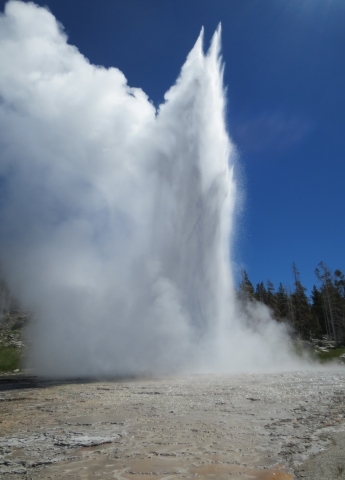
Grand Geyser (2013)
Here is an excerpt from an article in the February/March 2018 issue of The Geyser Gazer Sput that went straight to my heart. This family,the Altstidl’s, lives near the Bavarian Alps.GOSA: How long have you been geyser gazing?
The parents first fell in love with Yellowstone in 1994 and so decided to return in 1997 with the twin boys. They were only 13 months old, but not too young to enjoy Echinus Geyser. Since 2001, we have been coming back to this beautiful place every year and, with time, developed our passion for geysers. While waiting for our first major geysers like Grand and Great Fountain, we were taught about the things to look for by a lot of very helpful and friendly people and learned they were part of the GOSA community. We began subscribing to the Geyser Gazer Sput in 2007 and have enjoyed being part of the community ever since.
GOSA: How did your family begin geyser gazing?
Initially, we used the predictions provided by the National Park Service. We still remember waiting for Madison VC to open on our way from West into the basin to get some information and plan our day. Those were the days before we had the Internet! With the children still in a stroller we already tried to wait for at least Echinus, Daisy and Grand. We were so lucky that the boys were very patient.
But I think what really got us hooked in the first place was the nice atmosphere while waiting for Great Fountain. The anticipated eruption with sparkling diamonds combined with blue at the bottom just took our breath away. It was there where Jeff Davis and Lynn Stephens started teaching us where to look to make our “own” predictions and told us about other geysers not predicted by the NPS like Fountain and Artemisia. After that we got “fireworks” at Grand; rainbows at Beehive; thumps at Oblong; playful, never tiring Fountain; mystic, blue-green Artemisia; soaking, funny Fan and Mortar; and graceful, blue and high Morning. So many eruptions which brought us joy and delight, but also the feeling of awe and gratefulness. We always saw something new or interesting. Attached to almost every geyser are memories of people sharing knowledge and giving advice. Such an openness, especially towards foreigners, was what made it special and we feel like part of a huge family now.
Excerpted from The Geyser Gazer Sput, Vol. 32, No. 1, February/March 2018, by permission of editor Pat Snyder. Photo credit: Beth Chapple, June 23, 2013.
I’ve been privileged to see eruptions of all ten of the wonderful geysers mentioned here, even though I get only a very limited time in the Upper Geyser Basin each summer. The Altstidl’s mention of their children being patient reminds me of how my then-six-year-old granddaughter Lexi made no complaint about our hour-long wait for Grand Geyser to erupt; perhaps small children sense that something wonderful is about to happen.
You, too, can become a member of the now thirty-year-old Geyser Observation and Study Association. Write c/o Bill Johnson, PO Box 5031, White Rock NM 87547; email store@gosa.org; or sign up on the website: www.gosa.org.
February 12, 2018
Encourage teens to join the Youth Conservation Corps
Youth Conservation Corps members at Inspiration Point, Yellowstone National Park (NPS photo, circa 2012)
The National Park Service is announcing that the deadline to apply for one of the two month-long sessions at Yellowstone this summer is rapidly approaching: March 1, 2018. This will be the 29th straight year that the Youth Conservation Corps is offered in Yellowstone National Park. Sixty young people between the ages of 15 and 18 can participate in this program, which has educational, recreational, and work aspects. Teens help NPS staff with trail and campground restoration, resource management, visitor support, maintenance, and more. “Applicants should possess a positive attitude, a willingness and ability to work in a physically active outdoor program, and get along well with others,” according to the press release. What a great opportunity! For more information and to obtain the application, see the YCC page on the official Yellowstone National Park website.
January 12, 2018
Unique experiences in the park
Mud Volcano area in winter (2012)
While everyone knows that visitation just keeps increasing in Yellowstone, most of us are seeking ways to make our own trips unique and special to us. New Deputy Superintendent Pat Kenney says in the winter 2017 issue of Yellowstone Quarterly from Yellowstone Forever, “I have always enjoyed finding the subtler things that make our park special.” His example is “it is great to spend an evening up on Swan Lake Flats, listening to the snipe and watching the Milky Way appear.”Author Janet Chapple aims to help with this quest, even including a list of “Less Well-known Yet Beautiful Places” on page 19 of the Yellowstone Treasures guidebook to help with your planning. As she writes in the preface, “Yellowstone means many things to many people: bears and bison, geysers and colorful pools, hikes and horseback rides, distant vistas and the stillness of the backcountry. It can also mean clear dry western air, spectacular sunsets, and night skies so full of stars you think you’re seeing to the end of the universe.”
Through Early Yellowstone compiles a variety of stories from long ago, and each travel writer has his or her own encounter with joy or amazement. Make sure to take advantage of our 25% off sale while it lasts, just through January 31, 2018.
May your 2018 include unique experiences in Yellowstone and our other national parks! You are welcome to share some highlights of your trips in the comments.
Beth Chapple, Editor and Publisher
November 3, 2017
Good news for visitors to Mammoth Hot Springs
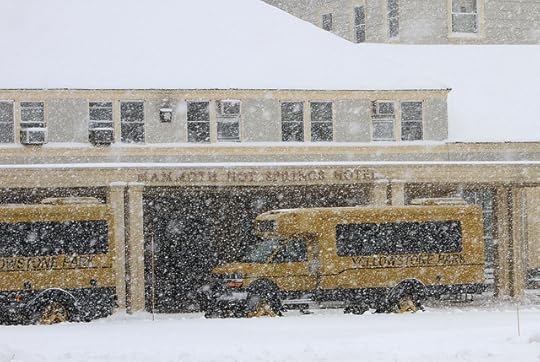
Mammoth Hot Springs Hotel with snowcoaches in winter
I had learned a couple of years ago that the historic hotel at Mammoth Hot Springs would be closed during the winters of 2016-17 and 2017-18 for major reconstruction. Now plans have changed, according to the Public Affairs Office; right now you can reserve rooms for winter visits, starting on December 15th, with the dates similar to those for the Old Faithful Snow Lodge and Cabins. Visit Xanterra’s Winter Lodges page or call 1-307-344-7311 to book your room.
Starting in fall 2018 through winter season 2018–19 you will find the hotel closed again for further work on the interior, but I expect the related cabins, the dining room, and the casual Terrace Grill will be open.
Incidentally, in recent summers I’ve found meals in the pleasant hotel dining room—located across the street from the hotel proper—to be excellent. So far, this dining room has not required advance reservations, but that could change.
Photo credit: Jim Peaco, National Park Service, December 12, 2012
October 26, 2017
Proposed fee changes for national parks
The National Park Service has announced a proposal to charge larger fees for seventeen of its most popular parks, beginning next spring. I learned about this through the excellent KQED California Bay Area radio program, “Forum,” and considered registering a comment with the NPS.
Considering the dire condition that many of our parks are now in due to underfunding by the federal government, it probably makes sense to raise entrance fees for people who are actually using these parks, especially during the busiest seasons (May through September for Yellowstone).
A caller to the program brought up the subject of charging more for people from other countries than for U.S. citizens—a thought that had also crossed my mind while I was listening. After all, when Congress passed the 1872 act setting aside Yellowstone, the very first national park in the world, they stipulated that it was “for the benefit and enjoyment of the people,” and chances are they were thinking of American people. Whether or not charging more for foreign visitors is a good idea (and I’m not sure it is), that is not a consideration included in the present proposed fee change.
Decide for yourself whether this fee hike would be a wise move by going to: [link] the NPS website.
September 30, 2017
2017 national parks photo contest
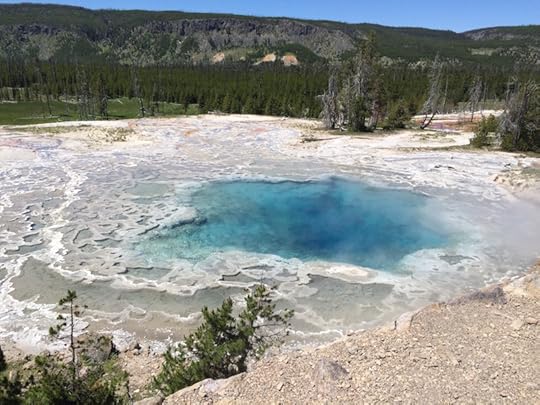
Artemisia Geyser near Biscuit BAsin
Happy National Public Lands Day! Did you know that admission to all U.S. national parks is free today? National Public Lands Day is always on a Saturday in late September, and some parks hold special events.To celebrate, we would like to be sure you know about the Official Federal Recreation Lands Photo Contest, “Share the Experience.” This contest is sponsored by the National Park Foundation and FindYourPark.com/EncuentraTuParque.com. Through December 31, 2017, amateur photographers are invited to submit photos that highlight the best of America’s federal lands, national parks, and historical sites in various categories. The grand prize includes getting your image on the Annual Federal Recreational Lands Pass (2019), which is distributed to over 300,000 people annually, plus $10,000 and a bunch of camera gear. Wouldn’t it be cool to see an image from Yellowstone National park on the pass? The 2nd and 3rd prizes also include money and camera gear. You can see the winning photos from 2016 as well as more recent photos in the gallery at the Share the Experience website. That is also the place to learn about the contest rules and guidelines.
—Enjoy! Beth Chapple, Editor and Publisher
Photo Credit: Janet Chapple, June 2015. You can reach Artemisia Geyser’s beautiful pool and formation in one of two ways. One is by walking beyond Riverside Geyser about half a mile up what used to be the main road and is now a rather rough trail past Morning Glory Pool (page 95 in Yellowstone Treasures) or by parking at Biscuit Basin and crossing the road to reach the other end of the trail from Morning Glory Pool.
September 7, 2017
What Yellowstone owes to Dr. Hayden
Broad and beautiful Hayden Valley is where today’s visitors are most likely to see herds of bison close to—or on—the road. The valley is named for Dr. Ferdinand V. Hayden, born on September 7, 1829. He played a large role in the creation of Yellowstone National Park.
Trained as a medical doctor at Albany (NY) Medical School, Hayden served as a surgeon in the Union Army until 1865. However, he became interested in geology through collecting and studying fossils in the Dakota Territory and in 1867 began his government-supported geological surveys of the west.
During the summers of 1871, 1872, and 1878, the Hayden Survey studied the Yellowstone area systematically. The men observed and reported on many geological and other phenomena in voluminous reports. The report of Hayden’s first exploration was essential in convincing Congress to establish YNP in 1872.
Hayden’s love of geysers and hot springs reportedly could move him to tears. As an early guidebook writer observed: “He cannot compose himself in the presence of a geyser in eruption; but, losing recollection of the material world for the time, rubs his hands, shouts, and dances around the object of his admiration in a paroxysm of gleeful excitement.”
August 30, 2017
Bison in town? Oh my!
Toward the end of a remarkable Montana Public Radio series we see and hear from high school students in Gardiner, Montana, who have learned how to get along with bison on their football field. Now I know how they get rid of the bison patties I’ve often seen there, especially in winter and early spring. Students with detention get to pick them up and put them in buckets.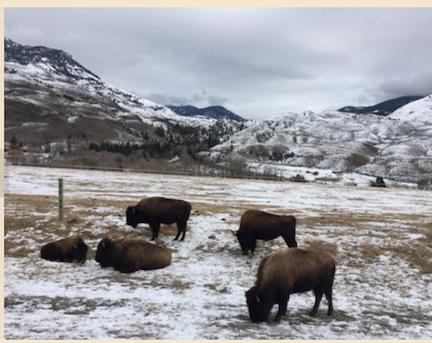
Bison in north central Montana from MPR podcast, Episode 1
I first mentioned the seven-part podcast titled Threshold from MPR in my May 17th blog post. Since then, I’ve made it a point to listen to all the parts. It’s well worth the half hour each one takes. Amy Martin and her team are doing a superb job giving us a balanced and often moving report on what is being done to bring large numbers of bison back to northern Montana’s plains. Until the end of the nineteenth century, an estimated sixty million of them roamed the Great Plains and were essential to the natives’ way of life.
In the Yellowstone Treasures section on Living Things, I explain that the bison “symbolizes the wide open spaces of the West. Ironically, the bison is also probably the most grievous case of man’s wanton destruction of a natural resource in America’s history. Not only did hunters nearly eradicate the bison during the late 1800s, but the slaughter was actually encouraged by the government to suppress the Native American Indians who depended upon them.”
Listen to the MPR podcast to learn what Montana’s tribes and other interested people are doing to help restore bison to the plains.

